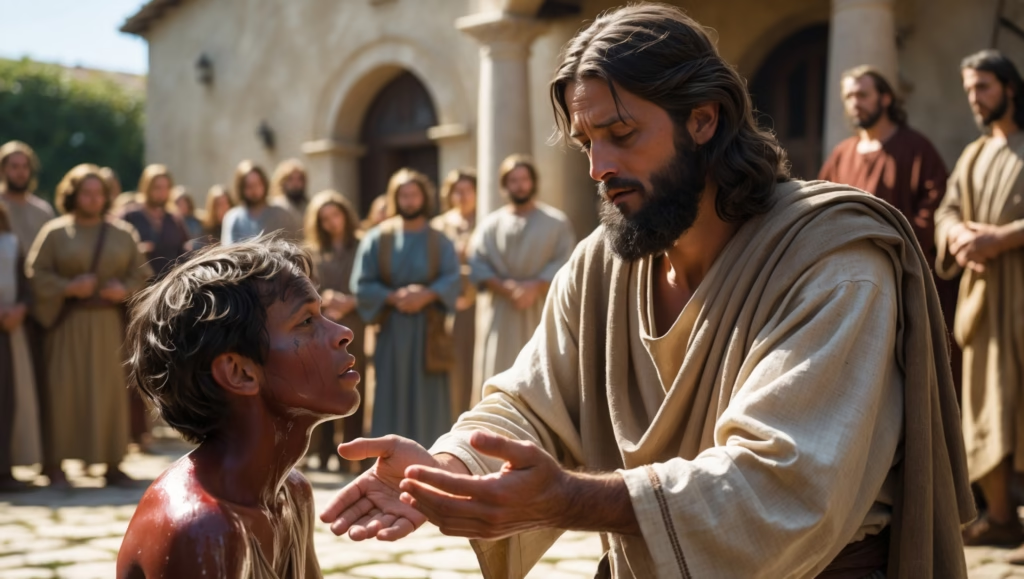The Gospels recount numerous instances of miraculous healing, but few are as medically intriguing as the story of the demon-possessed boy (Mark 9:17–29). In this narrative, Jesus restores a child afflicted with convulsions, foaming, rigidity, and other dramatic symptoms. Modern neurologists have revisited these accounts to explore whether they represent genuine divine intervention, misunderstood neurological disorders, or culturally framed phenomena.

The Biblical Account
Mark 9:17–29 introduces a desperate father bringing his son to Jesus. The child exhibits:
- Convulsive episodes
- Rigidity and uncontrolled movements
- Foaming at the mouth
- Occasional muteness
The crowd remarks that the boy’s suffering is longstanding, and prior attempts at healing, including exorcisms, have failed. Jesus rebukes the unclean spirit, restoring the boy instantaneously.
Medical Analysis: Epilepsy and Other Disorders
Modern neurologists recognize that the boy’s symptoms resemble generalized tonic-clonic seizures, historically called “falling sickness.” Key observations include:
- Foaming and Salivation:
Excessive saliva during seizures is common, often accompanied by frothing at the mouth. - Rigidity and Muscle Spasms:
Sudden tonic contractions and postictal flaccidity mirror classical seizure patterns. - Altered Consciousness:
The boy’s periods of unresponsiveness align with seizure activity. - Failure of Conventional Remedies:
Herbal remedies, folk exorcisms, or priestly interventions often fail in true epilepsy, consistent with the narrative’s note of prior inefficacy.
Dr. Sanjay Gupta (CNN, neurology consultant) highlights the striking speed and completeness of the healing as inconsistent with natural disease progression, suggesting a phenomenon beyond typical neurological intervention.
Differential Diagnosis
While epilepsy fits the primary symptoms, scholars have also considered:
- Hypoglycemia: Sudden metabolic drops can cause convulsions, foaming, and fainting.
- Tourette’s or Movement Disorders: Some tics may be misinterpreted as possession in ancient cultural contexts.
- Psychogenic Seizures: Psychosomatic episodes triggered by stress or trauma may have been perceived as demonic affliction.
However, the immediate cessation of all symptoms after Jesus’ intervention challenges a purely medical explanation. Epilepsy, for instance, is rarely resolved instantaneously, even with modern anticonvulsants.
Cultural and Historical Context
In first-century Judea, neurological disorders were often interpreted through spiritual lenses:
- “Demon possession” was a prevalent explanation for behaviors outside social norms.
- Ritual purification and exorcism were standard treatments, reflecting the blending of medical observation and religious practice.
- The boy’s chronic condition would have stigmatized the family, reinforcing social and psychological pressure.
Understanding the story within this framework illuminates the cultural interpretation of disease while raising questions about the interface between faith and medicine.
Modern Miracle Parallels
Contemporary miracles often feature individuals with seizure disorders:
- Lourdes, France: Approximately 23% of recognized “miracle” cures involve conditions resembling epilepsy.
- Faith healers worldwide report sudden remission of convulsive disorders during prayer or ritual, though scientific verification remains controversial.
These cases illustrate how extreme neurological events continue to be perceived as miraculous, bridging science, spirituality, and psychology.
Theological Implications
Jesus’ healing demonstrates multiple layers of significance:
- Authority Over Nature and Disease:
The narrative portrays a healer who can override chronic pathology, challenging assumptions about human limitation. - Faith and Healing:
Jesus repeatedly emphasizes the necessity of belief (Mark 9:23–24), linking spiritual openness with physiological restoration. - Redefinition of Suffering:
By curing the boy, Jesus not only addresses physical symptoms but reframes social and spiritual stigma, offering restoration of dignity and inclusion. - Foreshadowing of Divine Power:
Instantaneous remission of symptoms serves as a symbolic template for later resurrection miracles, where normal human physiology is transcended.
Neurology Meets Theology
Studying this miracle through modern neurological frameworks provides unique insights:
- It clarifies the severity of the child’s condition, illustrating that the healing required profound intervention.
- It contextualizes cultural misinterpretation, showing why the boy was labeled “possessed.”
- It underscores the theological claim that Jesus’ power surpasses natural law, a cornerstone of Gospel testimony.
While skeptics may argue for psychosomatic explanations, the full resolution of chronic convulsions in a first-century context remains medically extraordinary.
Ethical Reflections
Examining the story scientifically does not diminish its spiritual meaning:
- It emphasizes the importance of integrating faith and medical ethics in modern pastoral care.
- Raises awareness of historical misunderstandings of neurological disorders, potentially reducing stigma today.
- Highlights how miracle narratives communicate compassion, societal transformation, and hope beyond pure biology.
Why This Matters Today
Exploring the neurology of miracles illuminates ongoing intersections between science, medicine, and faith:
- Medical professionals can learn from historical interpretations to improve care for patients with misunderstood conditions.
- Religious communities can better appreciate the transformative social and spiritual dimensions of healing stories.
- Scholars and educators can use this lens to bridge ancient texts and contemporary science, fostering nuanced interdisciplinary dialogue.









